If you want to include already-published figures or photographs in your article, or reproduce a portion of text or tabular material, or even include something that someone has said to you as a personal communication, it can be confusing when you try and navigate the process of seeking permission. Generally, something that has already been published will be ‘owned’ by someone and under copyright and require permission to reproduce it. This Top Tips is intended to clarify the procedure and help you establish exactly when (and from whom) you should seek permission.
Quick Links: 1. Licensing bodies and length of copyright |
2. Your responsibilities as author |
3. When you don’t need permission |
4. The STM Permissions Guidelines |
5. Rightslink |
6. I want to reuse a figure from a paper authored by me |
7. I want to reuse a figure from a paper authored by someone else |
8. I want to reuse a figure from the Internet |
9. I want to reuse a figure from an Open Access paper |
10. I want to modify or redraw the figure |
11. Credit line |
12. I can’t find the copyright holder |
13. What do I ask for and what information do I need for Rightslink? |
14. Personal communications |
Useful example extracts and required wording
In the UK, and across the EU, the period of statutory copyright protection is either
(a) 70 years from the end of the year in which the author died or
(b) 70 years from the year of publication, if copyright rests with the publisher.
This period may be different for earlier works or works of foreign authors not first published in the UK.
Many scientific publishers use licensing bodies to manage their permission-granting services and you will probably encounter the Copyright Clearance Center (CCC) and the Copyright Licensing Agency (CLA) at some point. While CCC is based in the USA and owns and manages the RightsLink permission-granting service (www.copyright.com), CLA is based in the UK and operates the PLS Clear transactional permission service (www.cla.co.uk). You may also come across an initiative called The Copyright Hub (www.copyrighthub.org), which links to the network of rights registries and copyright-related databases to facilitate cross-border and cross-sector copyright licensing.
As author (or corresponding author), you are responsible for obtaining permission to use
- any copyright material in the article that you are submitting to one of our journals or books;
- any information obtained privately (e.g. in conversation, correspondence or discussion with third parties and included within your manuscript as a personal communication; see point 14).
By ‘copyright material’ we mean any material that has been published elsewhere – whether in a printed or electronic format. This applies to direct text extracts, tables or figures. In most cases, the publisher of the work will control copyright in the material and has the exclusive right to grant permission even if they don’t own the copyright. For example, when you publish with the Geological Society, you – as author – retain copyright of your work (or perhaps your employer will) but you assign us licence to publish it and deal with any requests to republish material from the paper (if someone asks permission to reproduce more than three figures from your article, we do ask them to seek your consent directly).
The copyright holder will usually require you to acknowledge the original source in your figure or table caption using specific wording (see point 11). You should follow this wording exactly.
If the copyright holder requests a permission fee, you are responsible for payment. Note that we cannot publish your work without proof of your permissions and confirmation that your reproduced figures have been correctly acknowledged. You should submit/upload the written permission(s) from the copyright holder(s) with your manuscript. If your permission request is via Rightslink, you will be given the option to save a printable licence as a PDF (as shown in the screen grab below):

If you do this, you can upload the PDF(s) with your manuscript when you submit. Any permission documents can be uploaded as ‘secondary source permissions’ in Editorial Manager, our submission system.
Requesting and obtaining permission can take from a few minutes to several months so allow plenty of time for this process and begin as early as possible.
There are many occasions when you won’t need to seek permission to publish figures and tables.
- If all figures, diagrams, tables and text in your article are your own (or your co-authors’), original, unpublished work.
- If you have created an original figure or table from data or factual information that was not previously in figure or table format (but you will need to acknowledge the source of those data).
- If the image was published more than 70 years ago (see point 1).
- If you want to reuse your own published material in your PhD thesis, most publishers will allow this. For example, we do not require you to ask permission to use in your unpublished thesis any of your material that appears in a GSL article, provided that you acknowledge the published source and do not use the typeset PDF if your thesis is to be hosted online. The Geological Society of America (GSA) requires no permission request but asks that you cite the published paper and use their credit line.
- If the material is in the public domain it is not subject to copyright. For example, work published by US government agencies is generally in the public domain and can be reproduced without permission, but the source should be acknowledged. If the figure you
- The Geological Society of London is a registered Charity no. 210161
- want to reuse appears in a work made by an officer of the Crown, it will be under UK Crown copyright and can, in the main, be used without permission via the Open Government Licence, but acknowledgement of the source must be included.
- If the figure is Google Earth content it needs no permission but you must provide attribution to both Google and the data providers (see point 8).
- If you are reusing only one or two figures from a publication, some publishers may not require you to obtain written permission but they will expect acknowledgement of the source. For example, GSA and AAPG consider use of a single figure or a single table from their publications to be fair usage, requiring no formal permission; the Society of Economic Geologists (SEG) considers use of up to three figures or a single table to be fair usage; we are happy for you to reuse your own figures in another publication or reuse up to three other GSL figures or items without seeking permission.
- If the figure has come from an Open Access work, published with a CC-BY user licence, such as one of our Gold Open Access articles, you are free to ‘copy and redistribute the material’ and ‘adapt … and build upon the material for any purpose’ (see point 9). There are different Creative Commons licences (CC-BY, CC-BY-ND, CC-BY-SA etc.: CC licence types) and the article containing the figure that you want to reuse will have a link to its licence so that you can check to see exactly what is allowed in terms of reuse. Remember that our publishing activity will fall under the remit of ‘commercial’ so you could not reuse a figure from a CC BY-NC-licenced publication, for example. You cannot assume that all figures in an Open Access article carry the CC-BY licence – the author may be using third-party material. Check each figure caption to make sure the figure you want to reproduce does not require permission from an original source.
GSL is a signatory to the Guidelines of the International Association of Scientific, Technical and Medical (STM) Publishers, which makes navigating the confusing world of seeking permissions much easier for our authors. The Guidelines facilitate the exchange of scholarly and professional information by enabling one STM signatory publisher to grant permission to another to reuse limited amounts of material from published works in subsequent publications. This is free of charge and often without the need for you to request permission. Many scholarly publishers are signatories to the Guidelines (e.g. CUP, Elsevier, ICE Publishing, John Wiley, OUP and SpringerNature). You can see the full list of signatories in tabular form here and it lets you know which publishers do still expect you to apply for permission, even though they will grant you permission free of charge.
If you want to reproduce figures from an article in a book or journal that is published by another signatory to the Guidelines, you will be able to use free of charge up to three figures (including tables) from a single journal article or book chapter.
There are caveats:
- you cannot use more than five figures from a whole book or journal issue/edition;
- you cannot use more than six figures from an annual journal volume;
- you cannot use in total more than 30 figures from a single publisher for re-publication in a book, including a multi-volume book, with different authors per chapter;
- if any figure(s) you want to reproduce are credited to another source (third-party material), you must clear this with the stated copyright owner;
- adaptations or modifications are not permitted without prior permission from the publisher.
Rightslink recognizes signatories to the STM Guidelines. When you seek permission through Rightslink, it will give you the option to input that you are publishing your article with an STM signatory or it will supply the publisher’s name in a dropdown list. For example, you will see ‘Geological Society of London’ in the dropdown list. In many cases, when you want to reuse a figure you just click on the opening page of the article from which you want to take the figure. The link will read ‘Request permissions’ or ‘Get rights and content’ or ‘Reprints and Permissions’, and may be within a ‘Tools’ tab, depending on which publisher produces the article/chapter:
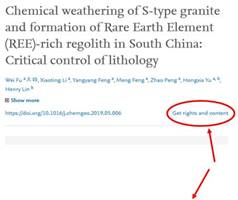
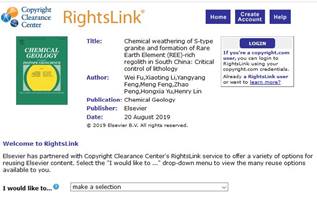
(a) From a GSL publication
You may reuse your own figure(s) without permission but you may not use more than 25% of any GSL published article in a single publication and no publication should contain more than 25% in total from a GSL publication. The original source should be fully acknowledged in the standard form and, if the material was published electronically, include the DOI in the reference list. This applies if your paper appeared in one of our books (Special Publications, Memoirs series etc.), our wholly-owned journals (Journal of the Geological Society and Quarterly Journal of Engineering Geology and Hydrogeology) or our co-published journals (Petroleum Geoscience and Geochemistry: Exploration, Environment, Analysis). If your original paper appeared in one of the journals that we publish for other societies (Scottish Journal of Geology and Proceedings of the Yorkshire Geological Society), you should contact each journal editor for permission (SJG editorial board; PYGS editorial board).
(b) From another publisher
Check who owns or administers the copyright of the original work – it is probably the publisher rather than you – and see if they are an STM signatory. If they are, do they want you to request permission to reuse the material?
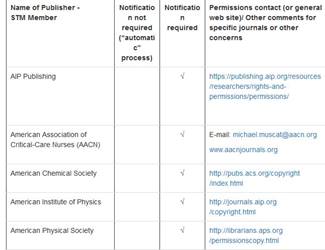
The original publisher (STM signatory or not) will usually give you permission to reproduce your own work free of charge, but you should still check to see if you need to seek permission. The easiest way to ask for permission is using RightsLink (see point 5). Most publishers use this service. Wiley, for example, says that although you do not need to obtain prior permission to reuse your own material from your Journal of Petroleum Geology article in a new paper that you’re writing, if your new publisher does require formal permission you can download this from RightsLink by selecting ‘Author of this Wiley article’ as the requestor type.
If the publisher of the figure you wish to reproduce does not use RightsLink, request permission directly from the publisher. There is usually a link or email address on the individual journal article or book chapter page on the publisher’s website for permission requests and this will take you to their contact point for obtaining permissions.
(a) From a GSL publication
You may use up to three figures or tables from GSL published material (our books, wholly-owned and co-owned journals) without permission or charge provided that a proper acknowledgement of the source accompanies the items. For more than three figures/tables, use Rightslink to obtain permission; there will be a charge of around $50 per item, depending on end use (see the section on ‘Fees for re-publishing GSL material’ here). If the three figures/tables all come from one individual article, you must also seek the author’s consent directly. If he/she does not respond within four weeks, you can assume that consent is given. Contact the author at the address on the original article, or use Google Scholar or another search engine to trace them. If the original paper published before 1980, we will take a more pragmatic approach to author consent.
If you want to use a figure from the journals that we publish for other societies (Scottish Journal of Geology and Proceedings of the Yorkshire Geological Society), you should contact each journal editor for permission (SJG editorial board; PYGS editorial board).
If the figure comes from Geology Today, which is published for GSL and the Geologists’ Association by Wiley, you should see their website for permission details.
(b) From another publisher
If the article containing the figure(s) that you want to reproduce is not published by us, check the publisher’s website and the article page and find the link ‘Request permissions’ or ‘Get rights and content’ or ‘Reprints and Permissions’ or ‘Get permissions’. Clicking on this will probably take you through RightsLink (see point 5). Follow their instructions. You will most likley be given permission to use the figure(s) for free.
If the publisher of the figure you wish to reproduce does not use RightsLink or one of the other permission-granting services, request permission directly from the publisher. When they grant permission they will advise you of the exact form of words they require for an acknowledgement. This usually includes a full bibliographic reference to the original publication and an acknowledgement that the material is reproduced with permission from the rights owner (see point 11).
Just because an illustration appears on the Internet does not mean that it is in the public domain and therefore free to use. You should find out the status of the image and who owns the copyright (the photographer, artist, agency, museum or library). You then need to get written permission from the copyright holder to reproduce the photograph or illustration in the paper that you’re writing. Try to get permission from the original source in the first instance. If the website does not provide an original source and/or the source is unknown to you, then you should seek permission from the website staff to reuse the material. Note that images on Wikipedia and Google are frequently posted without the knowledge or permission of the copyright holder and are quickly removed if the copyright holder raises an objection. It may be better to try and source a similar figure from elsewhere.
Google
You don’t need to request permission to use Google Maps and Google Earth content but you must provide attribution to both Google and the data providers. It is not sufficient to include only ‘Google’ as the attribution when there are third-party data providers cited with the imagery. Attribution information will appear automatically on the Google Maps and Google Earth imagery that you use; if you don’t include this text on the figure itself or if the text on the figure is so small as to be illegible, your figure caption must contain both ‘Google’ and the relevant data provider(s), for example ‘Map data: Google, DigitalGlobe’.

Articles that have the Open Access padlock logo can be used freely without permission.

If you do reuse any of the figures or other parts of the article you must acknowledge the author and the source of the material. There are different Creative Commons licences (CC-BY, CC-BY-ND, CC-BY-SA etc.) and the article containing the figure that you want to reuse will have a link to its licence so that you can check to see exactly what is allowed in terms of reuse. If GSL publish a Gold Open Access paper it is under the CC-BY 4.0 licence and you are free to ‘copy and redistribute the material’ and ‘adapt … and build upon the material for any purpose’. You should not assume that all figures in an Open Access article carry the CC-BY licence – the author may be using third-party material. Check each figure caption to make sure the figure you want to reproduce does not require permission from an original source.
Note: if you use more than 25% of an Open Access article or if more than 25% of your article comes from an Open Access article this could constitute duplicate publication and be in contravention of normal publishing ethics.
Modifying already-published figures or tables is a grey area. Some publishers say that if you adapt a figure (add or subtract some information) you should still seek permission from the original rights holder of the figure, whereas if you redraw the figure it will not require permission. In general, do not think that if you adapt/modify/redraw a figure it means that you can avoid seeking permission to use the figure from the original copyright holder. In order to dispense with permission from the original rights holder, the redrawn figure would have to be substantially different from the original and this is always a subjective decision. Removing the outside border of the original figure certainly does not constitute adaptation or redrawing!
In all cases, it is best to err on the side of caution and request permission to use your ‘redrawn’ or ‘modified’ figure. In fact, it may be necessary to submit your adapted version to the original rights holder when you request permission so that they can compare it with the original. In your caption acknowledge the original source of the figure and use the wording ‘Modified from’ if your amendments are small or ‘Adapted from’ if your amendments are more substantial.
If the figure you want to reuse was itself modified from another published figure, the rights holder will be the copyright holder of the original figure and they should be contacted rather than the author/publisher of the adapted figure.
If you create a new table using data or information from a table in an original work in conjunction with your own additional data, you do not need to seek permission for the use of the original table (as it is not strictly derivative use), but you should add the citation reference as a footnote to the new table, acknowledging that your table includes data and figures previously presented in [source] and provide the citation in the references.
You must acknowledge the source of any figure(s) you are reproducing within the caption to that figure. The copyright holder will often require specific wording and you should follow this wording exactly. For example, the American Association of Petroleum Geologists (AAPG) requests that you include in the figure caption ‘AAPG©[year], reprinted by permission of the AAPG whose permission is required for further use’.
If you have been automatically directed to RightsLink for permission, the correct wording can usually be found in the RightsLink licence and may appear on the second or third pages of the Terms and Conditions. For example, to use a figure from Contributions to Mineralogy and Petrology (a SpringerNature publication), they specify
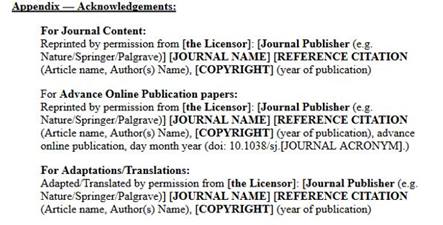
As a minimum, you should always include a normal reference citation to the work and then ensure that the reference list carries full information for that reference:
- if the figure is from a book: author, title, edition, publisher, city, country, copyright year;
- if the figure is from a journal article: author, title of article, title of journal, volume number, issue number (if relevant), page range (or first page if this is the only information available), date, publisher, and DOI number.
Sometimes it is difficult to trace the correct rights holder of the image or figure that you want to use – rights in the original article or item may have reverted to an author or transferred to another publisher. In this instance you have to make every effort to locate the copyright owner and keep a record of all correspondence as proof of your attempts to obtain permission. STM maintains a list of STM publisher imprints you can use to help determine the publisher of a particular imprint. Your efforts to locate the copyright holder constitute a ‘diligent search’ and the article or item may qualify as an ‘orphan work’ (www.copyrightuser.org/). You will still have to include a clear and adequate attribution to the original work, author, publisher and copyright holder, as appropriate and, if the copyright owner is subsequently identified, you may have to pay a reasonable royalty and not reuse the work unless agreed with them. You must never assume that a non-response allows you to use the material. If you really can’t trace the copyright holder it may be better to use a different figure instead.
The Geological Society of London needs you to request …
When you have established that you do require permission from the copyright holder to reuse the figure(s), you need to obtain permission to use the material ‘in this and all subsequent editions of this Geological Society of London work, its ancillaries, and other derivative works in any form or medium, whether now known or hereafter developed, in all languages, for distribution through the world’. If you are not given the opportunity to include such detailed wording, you must at least obtain permission for print and online publication in perpetuity. The Society cannot accept temporary licences.
Information you may need to key into Rightslink
If you have accessed Rightslink via a link on the opening page of the article from which you want to take the figure(s), all the original article information will have populated the relevant boxes in your permissions request.
You may then need to specify some of the following:
- where you want to reuse the figure(s) – in a book/ in a journal
- who is making the request – you
- Geological Society of London as the publisher name (this will appear in a dropdown list)
- what do you want to reuse – figure or table
- number of items you want to use
- in both print and electronic format
- will we translate – no
- the original figure/table numbers
- Book title and editor details (if going into one of our books) or journal details
- page extent
- pub date
- you may need the print run and distribution (for print run use 501-1000)
Examples of Filling in Rightslink requests for permission
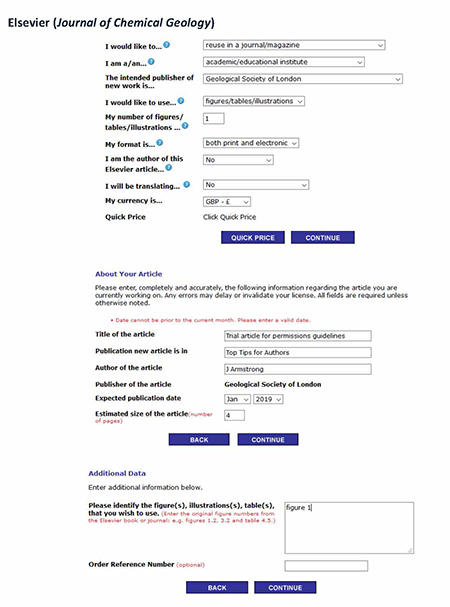
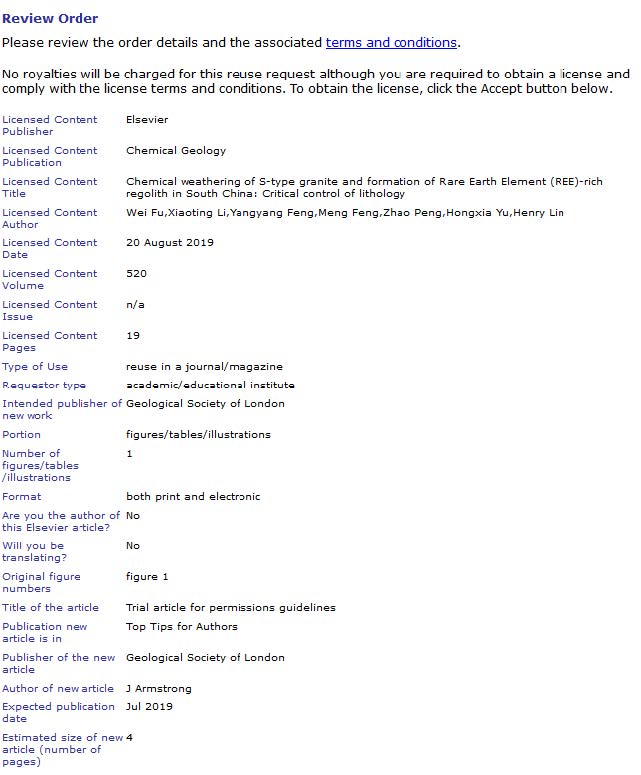
You should be aware that some publishers do not grant electronic rights for free and that you may have to pay a fee. GSL cannot help you with any costs that you may incur with permissions.
In general we do not allow reference to personal communications. Information obtained privately (e.g. in conversation, correspondence or discussion with third parties and included within your manuscript as a personal communication) must not be used or reported without explicit, written permission from the party from whom the information originated. This written evidence should be supplied with your manuscript on submission and can be uploaded as a ‘secondary source permission’ in Editorial Manager. It can be as simple as an email from the third party to say that they are happy with what you have put in your paper and attributed to them.
Summary
- Establish at least three months before upload of your final accepted manuscript if the material you want to reuse will require you to seek permission.
- Apply for permission through one of the permission-granting services.
- Keep a list of the figures going into your new paper:
Figure/table number
|
Original (created by you and not previously published)
|
Adapted/redrawn from a previously published article
|
Previously published in an Open Access format and no copyright holder mentioned in caption |
Previously published where – reference?
|
Permission required and granted? |
| |
|
|
|
|
|
| |
|
|
|
|
|
| |
|
|
|
|
|
- Chase responses if an immediate granting of request through RightsLink is not applicable.
- Where a specific acknowledgement is requested, insert this into the figure/table caption.
- Include evidence that permission has been granted when you upload your paper. Any material received without such evidence will be assumed to be an original from the authors or a figure that does not require permission.
Useful example extracts and required wording
Here are some extracts from the permissions pages of journals and publishers that may host the content you wish to use.
- AAPG (AAPG permissions) states that ‘If you want to use a single figure, a brief paragraph, or a single table from an AAPG publication in a paper in another publication, AAPG considers this to be fair usage, and you need no formal permission. You are, however, required to provide proper citation.’ Also ‘Permission without a fee is granted to AAPG authors who wish to republish portions of their own work as long as AAPG copyright credit is given, “AAPG©[year]", and the phrase “reprinted by permission of the AAPG whose permission is required for further use”.’
- CUP (CUP permissions) uses PLSClear to process permission requests for their books and Rightslink for their journals and is a signatory to the STM guidelines. They say ‘in certain circumstances, permissions requests are not required from authors who wish to re-use original material they have written for a Cambridge publication, provided that the subsequent use includes a full acknowledgement of the original publication, together with the copyright notice and the phrase “Reprinted with permission”’.
- Elsevier (Elsevier permissions) is a signatory to the STM guidelines. They require the following wording when you reuse their material: ‘Reprinted from Publication title, Vol /edition number, Author(s), Title of article / title of chapter, Pages No., Copyright (Year), with permission from Elsevier [OR APPLICABLE SOCIETY COPYRIGHT OWNER].’
- Geophysical Journal International (OUP; GJI permissions) states that ‘You are not required to obtain permission to reuse figures (including tables) for academic, educational or non-commercial research for the following material provided full acknowledgement is given to the original source including Figure Number, Title of the Article, Author, Journal Title and Volume or Issue.’ OUP is is a signatory to the STM guidelines.
- GSA (GSA permissions) states that ‘If you want to use a single figure, a brief paragraph, or a single table from a GSA publication, GSA considers this to be fair usage, and you need no formal permission and no fees are assessed unless you or your publisher require a formal permission letter.’
- ICE (ICE permissions) state that ‘If you are author of the content that you wish to use, please simply cite us! … If you are not the original author, please visit the CCC … This will tell you whether you need to pay a fee. You don't need to pay a fee to re-use content published open access, or if you are writing a PhD’. ICE is a signatory to the STM guidelines.
- Royal Society of Chemistry (RSC permissions) states that if you are the author ‘You do not need to request permission to reuse your own figures, diagrams, etc., that were originally published in a Royal Society of Chemistry publication’ and ‘To request permission to reproduce material from a Royal Society of Chemistry journal please use RightsLink’. RSC is a signatory to the STM guidelines
- Society of Economic Geology (SocEcGeo permissions) states that ‘Use of up to three figures, a brief paragraph (up to 300 words), a single table, or the abstract from an SEG publication is considered to be fair usage, and no formal permission is needed … We expect the SEG publication to be cited with appropriate credit, i.e., fully and prominently’
- Society of Exploration Geophysicists (SEG permissions) follows STM permissions guidelines (you can use up to 3 figures from an article without needing permission or paying a fee) and states that ‘SEG requires that full acknowledgment of the source, including a DOI-based permalink (live in electronic versions), be used in any new work that includes SEG material’.
- SpringerNature (SpringerNature permissions) requires the following wording when you reuse their material: ‘Springer book/journal title, chapter/article title, volume, year of publication, page, name(s) of author(s), (original copyright notice as given in the publication in which the material was originally published) "With permission of Springer"’. Springer Nature is a signatory to the STM guidelines.
- Taylor & Francis (T&F permissions) ‘If you are seeking permission to use … figures, tables, illustrations or images from a Taylor & Francis book … contact our books permissions team’ and ‘If you are an author seeking permission to reuse your own material in another publication … submit your request through the PLSClear permissions management service’. For journals, T&F use Rightslink. T&F is a signatory to the STM guidelines.
- Wiley (Wiley permissions) state for JPG that ‘If you wish to reuse your own article (or an amended version of it) in a new publication of which you are the author, editor or co-editor, prior permission is not required (with the usual acknowledgements)’. Also that ‘Permission is granted subject to an appropriate acknowledgement given to the author, title of the material/book/journal and the publisher. You shall also duplicate the copyright notice that appears in the Wiley publication in your use of the Wiley material’. Wiley is a signatory to the STM guidelines.
*
*
With best wishes
The Production Team